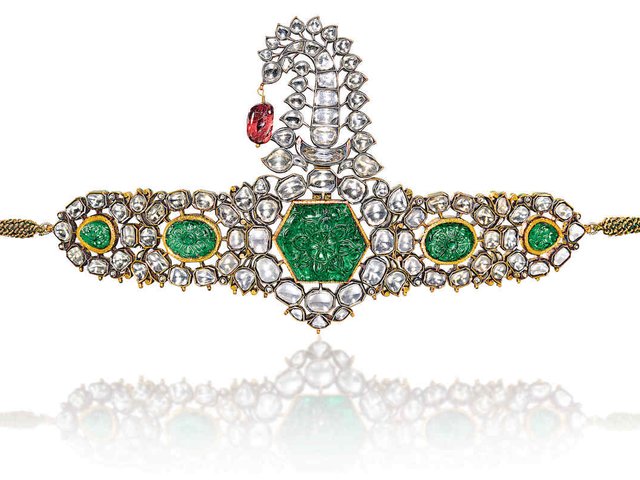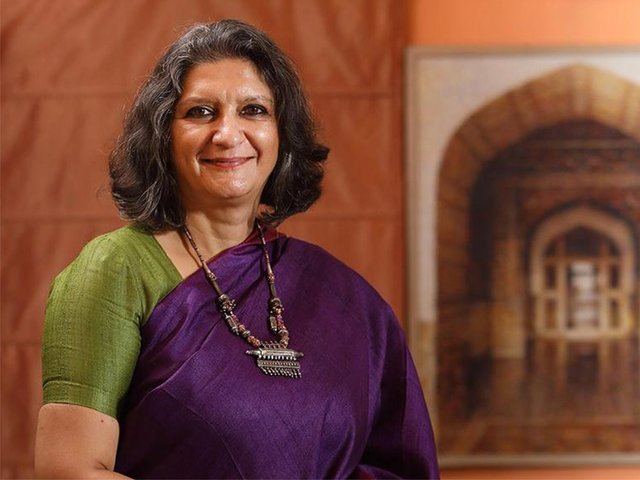London
The visually rich summer show at the Victoria and Albert Museum (V&A) has two strands: the historical and the art historical, both of great interest if not always in harmony. “The Arts of the Sikh Kingdoms” begins by exploring the history and religion of the Sikhs, whose egalitarian, monotheistic faith was founded by the Punjabi hymnodist Guru Nanak around 1500. In common with other mystics of the time, he proclaimed that in the eyes of God, “there is no Hindu and no Muslim.” His followers, called Sikhs or “disciples”, later suffered persecution by the Mughals, and with the inauguration of the Sikh Khalsa (community) in 1699 the faith became distinctly martial.
The great age of Sikh power came under the dynamic Maharaja Ranjit Singh (1780-1839), who extended his rule over a wide region. Ten years after his death the British annexed the Punjab. Ranjit Singh’s golden throne found its way to the South Kensington Museum, while the dispossessed Maharaja Dalip Singh lived at Elveden in Suffolk, became a favourite of Queen Victoria and a famous shot and was painted in flamboyant style by Winterhalter.
Against this background, the exhibition presents an impressive survey of the arts of the Punjab and Kashmir—paintings, textiles, metalwork, tilework and jewellery—from the imperial Mughal court at Lahore and the Rajput kingdoms of the Punjab Hills in the seventeenth and eighteenth centuries, as well as from Ranjit Singh’s court at Lahore (1801-39) and Sikh successor states such as Patiala.
The underlying paradox here is that many of the best things on show came from Mughal or Rajput patronage. The Sikhs themselves were not on the whole artistically minded. There is no Sikh art (as there is a Mughal or Rajput art), with a distinctive aesthetic formed by the sustained collaboration of innovative patrons and their court artists. Ranjit Singh, a diminutive, one-eyed man of great shrewdness and charisma, famously enjoyed the good things of life—including wine, women and the music of the flute—but had only limited interest in the visual arts. Sikh rule did however provide the conditions for a continuation (with sustained technique but lessening inspiration) of traditions established under the Mughals and Rajputs well into the Victorian era.
This exhibition, supported by the Sikh Foundation of California, has some outstanding, rarely seen loans from India, Pakistan, Europe and the USA (including the Kapany collection in the San Francisco Asian Art Museum). Some opulent jewellery has been lent from the Royal collection, including the so-called Timur Ruby and the emerald belt of Maharaja Sher Singh. Other loans range from Lahore arms and armour and a six-pounder cannon (Sikh militarism is given its due) to the charming family portrait of Jean-François Allard, one of Ranjit Singh’s French generals, with his Kashmiri wife and children. Allard also commissioned the delightful illustrations by Imam Bakhsh to a French edition of La Fontaine (some of whose Fables are the literary descendants of the ancient Indian Pancatantra).
Many objects are the V&A’s own. Besides Ranjit Singh’s throne, the Museum has superb shawls and other textiles and one of the best collections of Sikh portrait paintings, largely formed in the 1950s by the former V&A curator, W.G. Archer. In his 1966 catalogue Archer had already sought to rebut the received view of the Sikhs as merely “...humble products of the Punjab plains, newcomers to Indian culture and, in origin, rough and simple peasants... as non-artistic, it is urged, as that other ‘barbarous’ people, the Scots. Like Scotsmen, Sikhs have many good qualities—industry, courage, intelligence and tenacity... like the Scots, they have spread all over the globe. Go anywhere and you will find two persons—a Scotsman and a Sikh.”
This last remark is certainly true. The Sikh presence in Britain and America has been a motivating force for this show. For today’s curators, “multi-cultural society” and “outreach” are potent buzzwords. Whereas twenty years ago the V&A sent an exhibition of the “Arts of Bengal” across town to the Whitechapel Gallery and its neighbouring Bangladeshi community, and later a smaller show on Maharaja Ranjit Singh went to the Gunnersbury Park Museum near Southall (home to one of Britain’s largest Indian communities), now this art is taking pride of place in the South Kensington Museum.
This summer the V&A will pulsate to Punjabi drumming, music, folk-dancing, storytelling and martial arts, with quieter demonstrations of painting, calligraphy, metalworking and turban-tying. All of this is good education and fun too. However, one may still feel concerned that museums are less willing to undertake scholarly exhibitions of major phases of Indian art (early Buddhist sculpture, for example) which are less easily directed at resident ethnic groups.
The attractively illustrated book of The Arts of the Sikh Kingdoms, edited by Susan Stronge, again interweaves history and art. Excellent essays by eleven authors develop the themes of the show. Khushwant Singh and others write illuminatingly, if at times circumspectly, about Sikh history and religion, while B.N. Goswamy, Stronge and others ably discuss the arts of the Punjab and Kashmir. Book and exhibition both make good use of mid-nineteenth-century photographs, prints and watercolours, vividly evoking the age in which East India Company rule gave way to British Raj.
o “The Art of the Sikh Kingdoms”, Victoria & Albert, until 25 July; the Asian Art Museum of San Francisco, 22 Sept-9 Jan, 2000.
Originally appeared in The Art Newspaper as ‘Subcontinental splendour'



